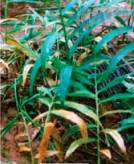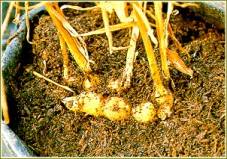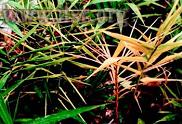|
Plant protection
Diseases : Soft
rot or rhizome rot, Bacterial
wilt, Leaf spot
Pests : Nematode,
Shoot borer,
Rhizome scale, Minor pests
Soft rot or rhizome rot

Soft rot-above ground symptoms

Rhizome rot symptoms
The disease is soil-borne and is caused by Pythium aphanidermatum, P. vexans
and P. myriotylum are also reported to be associated with the disease.
The fungus multiplies with build up of soil moisture with the onset of southwest
monsoon. Younger sprouts are the most susceptible to the pathogen. The infection
starts at the collar region of the pseudo stem and progresses upwards as well as
downwards. The collar region of the affected pseudo stem becomes water soaked and
the rotting spreads to the rhizome resulting in soft rot. At a later stage root
infection is also noticed. Foliar symptoms appear as light yellowing of the tips
of lower leaves, which gradually spreads to the leaf blades. In early stages of
the disease, the middle portions of the leaves remain green while the margins become
yellow. The yellowing spreads to all leaves of the plant from the lower region upwards
and is followed by drooping, withering and drying of pseudo stems.
Management
Select sites having proper drainage. Select seed rhizomes from disease free areas.Treatment
of seed rhizomes with mancozeb 0.3% for 30 minutes before storage and once again
before planting reduces the incidence of the disease. Cultural practices such as
selection of well drained soils for planting is important for managing the disease,
since stagnation of water predisposes the plant to infection. Seed rhizomes are
to be selected from disease free gardens, since the disease is also seed borne.
Application of Trichoderma harzianum along with neem cake @ 1 kg/ bed helps
in preventing the disease. Once the disease is located in the field, removal of
affected clumps and drenching the affected and surrounding beds with mancozeb 0.3%
or Cheshunt compound or 1.0% Bordeaux mixture checks the spread of the disease.
Top
Bacterial wilt

Bacterial wilt-yellowing and wilting symptoms
Bacterial wilt caused by Ralstonia solanacearum Biovar-3 is also a soil and seed
borne disease that occurs during southwest monsoon. Water soaked spots appear at
the collar region of the pseudo stem and progresses upwards and downwards. The first
conspicuous symptom is mild drooping and curling of leaf margins of the lower leaves
which spread upwards. Yellowing starts from the lowermost leaves and gradually progresses
to the upper leaves. In the advanced stage, the plants exhibit severe yellowing
and wilting symptoms. The vascular tissues of the affected pseudo stems show dark
streaks. The affected pseudo stem and rhizome when pressed gently extrudes a milky
ooze from the vascular strands. Ultimately rhizomes rot.
Management
The cultural practices adopted for managing soft rot are also to be adopted for
bacterial wilt. Seed rhizomes must be taken from disease free fields for planting.
The seed rhizomes may be treated with streptocycline 200 ppm for 30 minutes and
shade dried before planting. Once the disease is noticed in the field, all beds
should be drenched with Bordeaux mixture 1 % or copper oxychloride 0.2%.
PGPM- Seed treatment/ soil application –ATP,2 DAP, 4 DAP
Soil application of bleaching powder (15g) + lime (250 g/ 3 m2) –ATP, 2 DAP, 4 DAP
Seed treatment or soil application of Pseudomonas fluorescense (2%) + cowdung supernatant (2%) –ATP, 2 DAP, 4 DAP
Top
Leaf spot

Phyllosticta leaf spot
Leaf spot is caused by Phyllosticta zingiberi and the disease is noticed on the
leaves from July to October. The disease starts as a water soaked spot and later
turns as a white spot surrounded by dark brown margins and yellow halo. The lesions
enlarge and adjacent lesions coalesce to form necrotic areas. The disease spreads
through rain splashes during intermittent showers. The incidence of the disease
is severe in ginger grown under exposed conditions.
Management
The disease can be controlled by spraying Bordeaux mixture 1 % or mancozeb 0.3%
or thiram 0.2%.
Top
Nematode pests
Root knot (Meloidogyne spp.), burrowing (Radopholus similis) and lesion (Pratylenchus
spp.) nematodes are important nematode pests of ginger. Stunting, chlorosis, poor
tillering and necrosis of leaves are the common aerial symptoms. Characteristic
root galls and lesions that lead to rotting are generally seen in roots. The infested
rhizomes have brown, water soaked areas in the outer tissues. Nematode infestation
aggravates rhizome rot disease.

Dry rot in ginger due to Pratylenchus sp
Management
The nematodes can be controlled by treating infested rhizomes with hot water (50°C)
for 10 minutes, using nematode free seed rhizomes and solarizing ginger beds for
40 days. In areas were root knot nematode population is high, the resistant variety
IISR-Mahima may be cultivated. For control of nematode in endemic areas, apply neem
cake @ 1 t/ha at planting, followed by application of neem cake @ 1 t/ha at 45 days
after planting.
Top
Insect pests
Shoot borer

Symptom showing bore-hole with frass extrusion
The shoot borer (Conogethes punctiferalis) is the most serious pest of ginger. The
larvae bore into pseudo stems and feed on internal tissues resulting in yellowing
and drying of leaves of infested pseudo stems. The presence of a borehole on the
pseudo stem through which frass is extruded and the withered and yellow central
shoot is a characteristic symptom of pest infestation. The adult is a medium sized
moth with a wingspan of about 20 mm; the wings are orange-yellow with minute black
spots. Fully-grown larvae are light brown with sparse hairs. The pest population
is higher in the field during September-October.
Management
The shoot borer can be managed by spraying malathion 0.1 %. Spray dimethoate or
quinalphos @ 0.05%.
Top
Rhizome scale

Rhizome infected by scale
The pest can be managed by treating the seed material with quinalphos 0.075% (for
20-30 minutes) before storage and also before sowing in case the infestation persists.
Severely infested rhizomes are to be discarded before storage.
Minor pests
Larvae of leaf roller (Udaspes folus) cut and fold leaves and feed from within.
The adults are medium sized butterflies with brownish black wings with white spots;
the larvae are dark green. A spray with carbaryl (0.1 %) or dimethoate (0.05%) may
be undertaken when the infestation is severe.
Root grubs occasionally feed on tender rhizomes, roots and base of pseudo stems
causing yellowing and wilting of shoots. The pest can be controlled by drenching
the soil with chlorpyrifos 0.075%.
Top
|